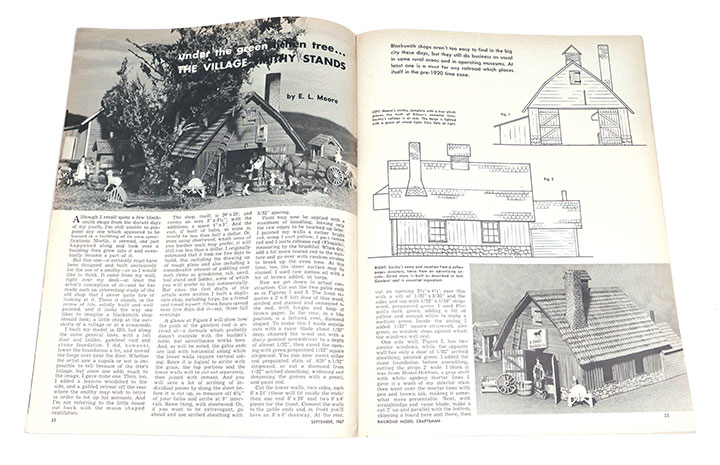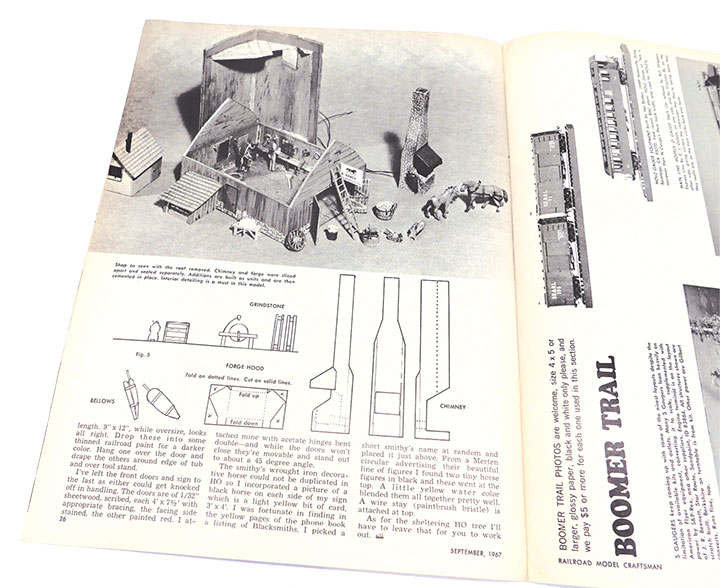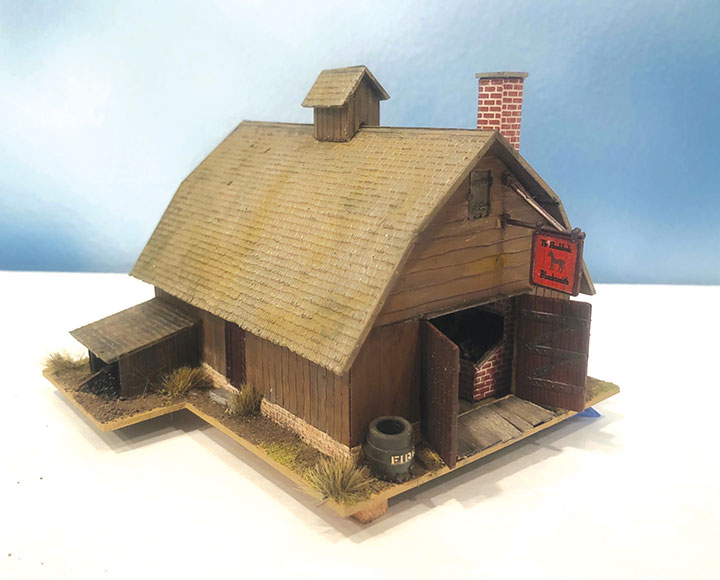It is no secret that I love structure modeling and therefore relish a new structure project. Like many other model railroaders, I also enjoy a bargain. Some months back, I stopped at one of the two remaining train shops in the Bay Area, and in the bargain-bin was a mint sealed HO scale AHM kit for the Village Smithy, a blacksmith shop in a small wooden barn. Now normally, I would have passed because a plastic kit for a wooden building presents its own challenges in transforming the plastic into wood, at least the appearance of wood. This kit appealed for a few reasons, however. First, it was a classic E.L. Moore design, replicating a structure Moore built as described in an article in the September 1967 Railroad Model Craftsman (RMC). Secondly, it included unique interior and detail castings. Thirdly, it was only $5.00, close to the original price when issued in 1971. Those factors proved irresistible and so home it came.
As luck would have it, I was caught up on review items so actually had time for a little project like assembling this kit. In so doing, I decided to see how far I could go in improving the basic look and detail level of this venerable styrene kit. But first, some words about the remarkable modeler who inspired the kit. To my surprise, Wikipedia has published a lengthy biography of E.L. Moore including a complete chronological index of his published articles in RMC, Model Railroader (MR) and Model Trains magazines, and even his unpublished manuscripts. I used the information from that source as well as retrospective articles in RMC and MR for this column. Some of the information conflicted so I exercised discretion in choosing what I believe to be the most accurate account.
Earl Lloyd Moore was born in 1898 on a farm somewhere in Southeastern Michigan, near Bangor. His father farmed but also was a school treasurer. One night, Moore’s father was robbed in his own home and the school money, stored in the family safe, was taken. The thieves made their getaway on a stolen railroad handcar later found abandoned. So, from his earliest age, E.L. was exposed to railroads. Later he served in the U.S. Navy during WWI. Wikipedia notes little is known of Moore afterwards until he appeared in Charlotte, North Carolina, in the late 1930s, “following a girl,” as he later explained it, where he spent the rest of his life. Before arriving there, he apparently worked in a paper mill in the Northeast and as a furniture salesman. When the Depression hit, Moore became a self-described vagabond for a while. After settling in Charlotte, Moore worked as a professional photographer, as did John Allen. He specialized in child and baby portraits from the late 1930s into the mid-1960s when his photographic studio burned down. Moore retired, becoming a full-time model railroader/author. Moore had started with Lionel O-27 in his early 50s but moved on to HO fairly soon. He must have been a quick study because by the time he was 57, just a few years after getting into the hobby, he began submitting articles. Between 1955 and 1980, he authored a remarkable 100+ feature articles, mostly structures, in MR and RMC as well as in Kalmbach’s Model Trains magazine. He also had photos of his work and small layouts published regularly. Small layouts because remarkably, Moore lived in apartments so there never was room for an elaborate layout. Many of his models were given to friends or traded.


I have fond memories of Model Trains as it was my first model railroad magazine and was geared toward the beginner. Moore’s folksy writing style and unusual but approachable modelling techniques appealed to me as a beginner. Moore almost exclusively used balsa wood; an inexpensive material generally scorned by serious modelers as too soft and coarse. Moore’s secret was using very sharp cutting instruments, so the balsa was not crushed and by the innovative use of the woodburning pen to create texture and detail in the soft balsa. This unusual technique, unique to Moore, was described in articles in the May 1955 issue of RMC and more completely in the July 1962 issue of MR. Using the woodburning tool and different tips, Moore was able to create weathered siding, shingles and a variety of textures obviating the need for commercial products. But it was an art not easily mastered as I discovered quickly. In 1963, I prevailed upon my parents to buy me a woodburning/soldering set with interchangeable tips. Balsa was and remains, inexpensive so with reckless abandon, I tried my hand at the Moore technique with little success. I discovered that as with any technique, the skill of the individual modeler was an unstated factor in its success. I still recall the smell of burning balsa. Moore also embossed bond paper over Northeastern corrugated wood to create his own paper corrugated roofing/siding and even formed paper pipes over dowels. As did John Allen, Moore created windows from inked mullions on frosted acetate. This was all very useful information for a new teen modeler on a tight allowance.
Moore was also known for creating a cast of Southern-oriented mythical characters and storylines for some of his articles. With a folksy tone, Moore employed Cousin Caleb, Grand Pappy Lucifer Penroddy Snooks, Uncle Wilber or P. Pottle, among others, in his stories. Years later, John Coots of SS Ltd. carried on the tradition with his own cast of characters for his HO figure line. My favorite, and a pseudonym he used on a memorable occasion with me for dinner reservations in Reno, was “J. Wolfgang Shagnasty, M.D.” Moore elevated his articles with his cast of characters and the title of his structure articles often reflected their names from Ma’s Place to Cousin Caleb’s Cabbage Plant, a factory not an agricultural product. He also delighted in cutesy names like W.E. Snatchem Undertakers, Grusom Casket Company, Hojpoj Manufacturing, Rhube’s Rhubarb Plant and Moe Lass Old Sorghum Mill. Later, noted plastic structure kitbasher Art Curren did the same with the Plaid Paint Company, among many others. Moore often placed an old-time HO photographer figure in the article photographs representing himself. On occasion, Moore would model a real building like RMC’s then Ramsey, New Jersey, headquarters, also later memorialized in an AHM kit. Indeed, AHM would create nine kits from Moore designs including Ma’s Place and W.E. Snatchem, faithfully replicating the names.
Moore was also interested in narrow gauge creating the 30-inch-square Enscale and Hoentee line, an N model railroad where Moore incorporated his HOn30 home-made equipment. He also created the HOn30 Eagleroost and Koontree Railroad, which existed only in picture form and authored an article on building a narrow gauge coach in the September 1961 RMC. His small home railroad was the HO scale Elizabeth Valley used as a background for his structure articles. All of these layouts were backwoodsy lines, down on their luck. They gave way after Moore married and had a daughter as the apartment had no room for both a family and even a small model railroad. He did much of his modeling on a TV tray. His most ambitious writing effort was Turn Backward O’ Time, two articles describing a multi-building old-time engine terminal in the January and March 1967 issues of MR. From approximately 1962 to 1975, Moore averaged a remarkable 6-8 articles a year in RMC and MR, often appearing simultaneously. He claimed he could create a new structure/article every two weeks. This pace was maintained almost until his death in August 1979. He was memorialized in the November 1979 issue of RMC and the February 1980 MR.

The AHM Village Smithy kit represented this proud heritage and faithfully reproduced Moore’s 1967 model. Assembly was ridiculously easy overall, but I was determined to upgrade it. The rather thick windows were replaced with finer similar castings from Grandt Line and Timberline. I maintain a large collection of window castings for this purpose and only had to do a small amount of trimming of the openings to obtain a good fit. The rest was stock, although I added additional interior parts, two figures and numerous small details. I also added lights to the interior and a small red bulb in a modified forge. After drilling a hole through the forge’s burning coal pile, I painted the remainder of the casting a coal and ash color after gluing pellets from a desiccant pouch. These pouches are normally found in electronics products to keep them dry. Toxic, so handle with care, the small opaque pellets within are perfect to glue onto a red/flame colored bulb so the color shines through, but is diffused. The edges are painted to resemble ash. For more realism, I could have employed a flicker circuit, but the color is enough for my purposes.

There have been many articles on painting styrene to resemble wood. I use a beige color paint as a base coat, later applying stains or thin washes of craft paint to create a weathered wood color. Finally, I dry-brush white or light gray to emphasize the grain. One advantage of styrene is the exaggerated grain molded in. A similar coloring process was applied to the roof shingles with an added layer of green pan pastels to represent moss. The best results come from experimentation. Buy a cheap styrene “wood” kit in any scale next time you are at a swap meet and use the walls/roof to experiment with coloration. The Smithy interior wall surfaces had raised part numbers and plain styrene finishes. I shaved off the numbers (saving the shavings for raised numbers in the future) and laminated discontinued Paper Creek green colored wood siding on the wall interiors. Dead flat, the paper siding creates an interior weathered wood siding look. With lighting, it is important to continually test for light leaks and bleeding where the thin styrene actually glows from the light within. Paint usually cures the bleed-through and here the roof interior was painted black for that purpose. I added scrap wood planks, miscellaneous junk, a workbench with tools and the assembled grindstone, quenching tub, and forge from the kit to complete the interior, although it is only visible from the open front doors or through the small side windows.
By the way, even though this is a plastic kit, there are still challenges in assembly. The design includes a gambrel roof; a complicated angled design which the kit resolves with clever scribed/segmented roof halves to be bent and fit to the gable. Similarly, the chimney/forge sides are segmented to fit the complex curves from forge to chimney. Each needs clamping and gluing to hold to shape. I used a combination of Faller styrene cement and ACC plus fingers to accomplish this. I drilled holes for the lighting wires and added some small corner posts to ensure the beveled wall corners were tight. I used the original base with its molded floor adding some scenic elements to hide the plastic edges. Finally, the plastic coal pile in the attached coal shed was overlaid with scale coal and weathered. So even simple kits can provide satisfaction if you elect to fine scale them as much as you can.
For me, the result was as charming as E.L. Moore’s scratchbuilt original. I certainly got my $5.00’s worth of enjoyment as well as yet another structure for my use. And I honored the memory of a truly unique character in our hobby. So, keep an eye out for the E.L. Moore kits out there from AHM, Campbell and others or better yet, get inspired by an E.L. Moore article and scratchbuild your own, preferably from balsa. Well, that’s all for now; until next time — write, if the mood strikes.